Known as the hen of the woods, maitake, sheepshead mushroom and signorina these delicious, bountiful fungi have lots of names and are king of the Fall mushrooms in the Midwest. In this post I'll tell you everything you need to know to find, identify, harvest, clean and cook them.
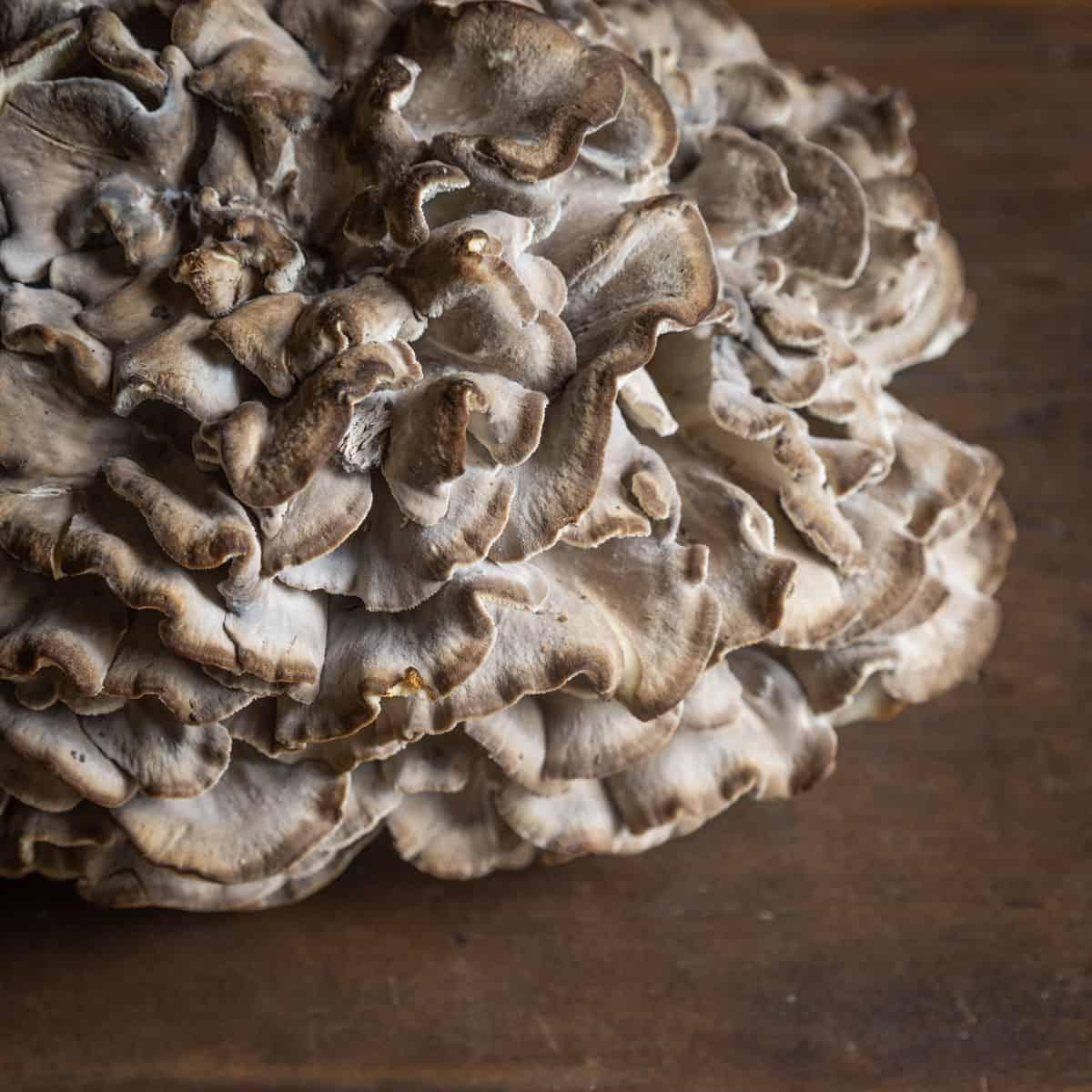
One of a few mushrooms only found East of the Rockies in North America, hen of the woods, (also known as Grifola frondosa) are a choice edible mushroom that grows at the base of trees. At a glance the mushrooms look like a roosting bird, which is where the name comes from. They're a parasitic polypore mushroom that infects living trees and injured trees, causing a butt-rot in the host.

Also known as maitake (dancing mushroom in Japanese) these have a long history of use in Japanese cuisine and culture. As legend has it, perfect mushrooms could be worth their weight in silver and harvested by samurai or given as gifts to the shogun. They're also prized in Japan for their (reputed) medicinal properties supporting the immune system.
How to Identify Hen of the Woods
One of the easiest, and safest wild mushrooms to identify for beginners, hens are easy to spot, even at a distance. Here's a few tips on properly identifying hen of the woods.
- Appears as a cluster at the base of trees, especially oak.
- Caps can be light to dark grey, smoky brown, or a combination.
- Are composed of rosettes of layered caps originating from a central stem.
- Instead of gills, the reproductive structure is white pores on the underside of the caps.
- Will grow on dead, dying, or downed trees, as well as stumps.
- Will occasionally grow directly from the roots of fallen trees and logs.
- They have a distinct fan-like shape, and the cap is layered with frilled edges or ruffles.
- Have a white spore print often visible on mature mushrooms.
- Bruise brown when handled over time.
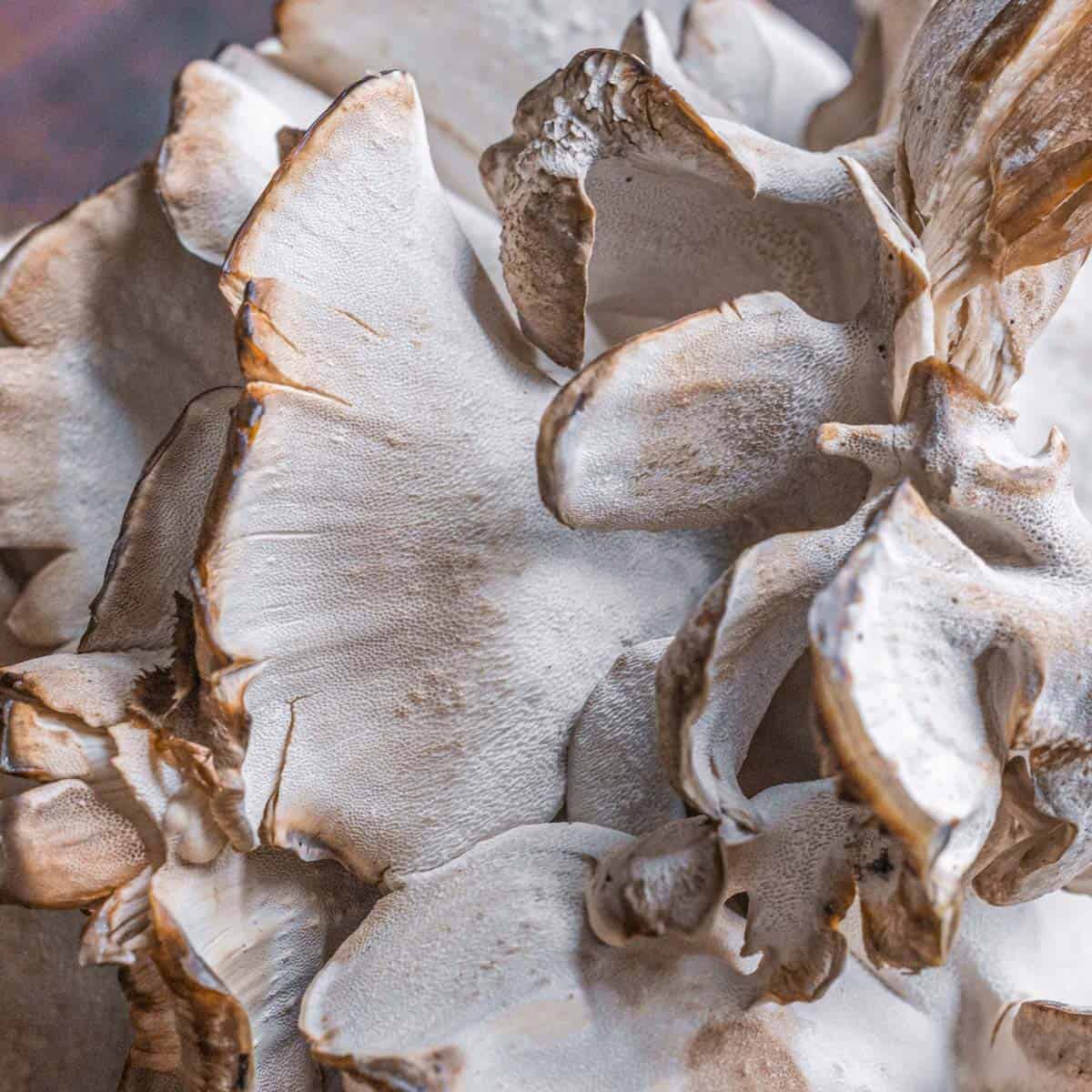
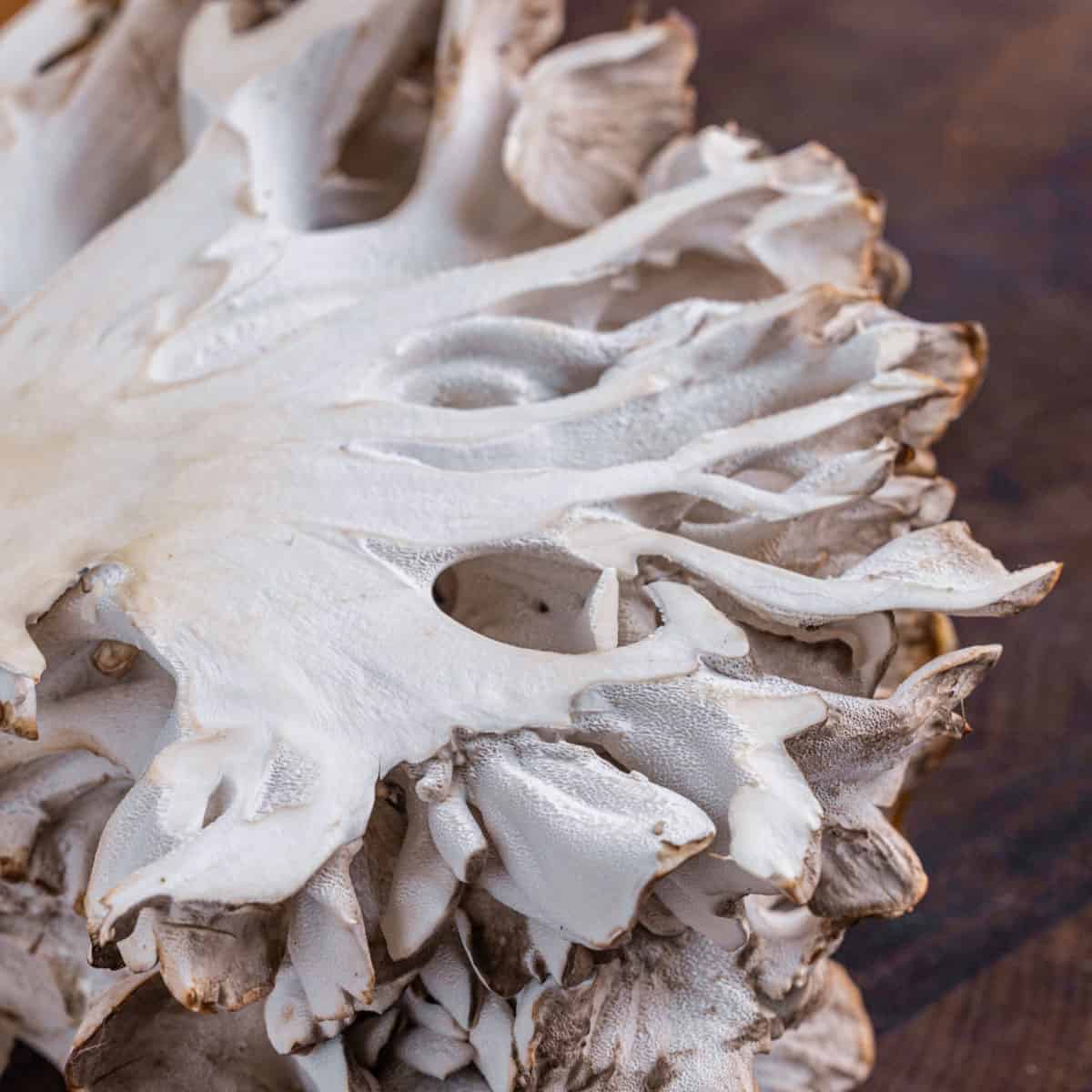
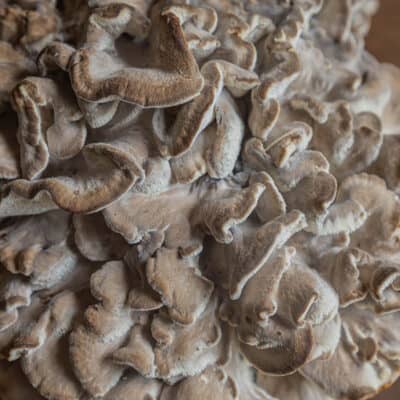
Where to Find Hen of the Woods
Where I hunt in Minnesota and Wisconsin, the easiest way to look for large, old oak trees. Red oaks seeming to be their preferred host.
Hens appear in late Summer around September and continue through the fall (October) but you might see an occasional one in August. These can grow to be massive, and I've picked clusters that have weighed thirty pounds.
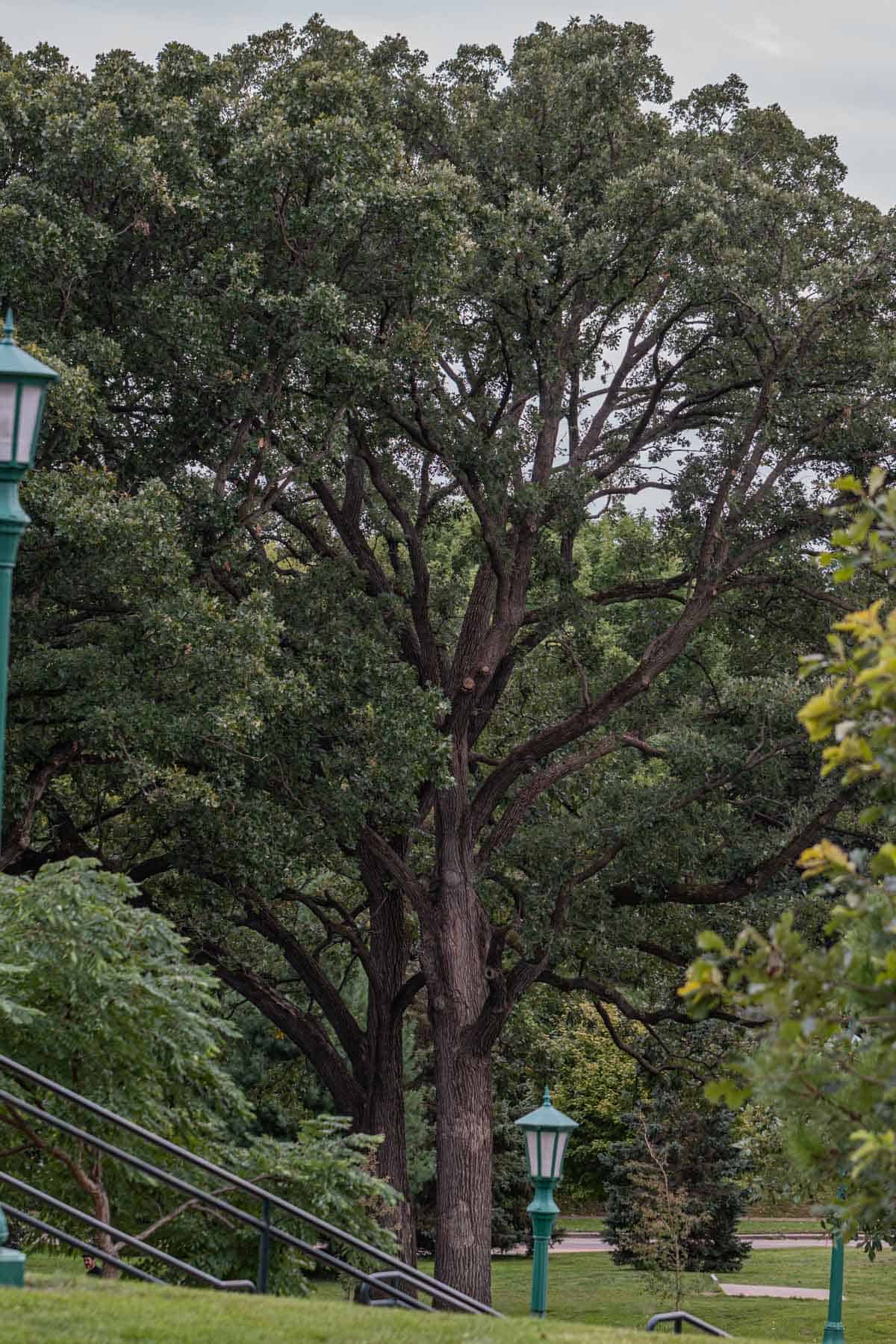
You don't need to be in the deep woods for these. Here's the best tips I have:
- The bigger the tree, the bigger the mushroom can be. Look to your nearest local park that has big old oak trees.
- If you're in an open, grassy area make sure the grass isn't being sprayed with chemicals, as happens on golf courses.
- Hen of the woods grow at the base of white oak trees, red oak trees, and rarely on maple trees.
- Hunting on bike helps you cover area quickly to find hens along paved trails.
- If there's one there's more. If one tree has a hen, then the whole grove has been infected. Look around the base of other trees in the area.
- Look for death and decay in woods that have lots of fallen trees and oak stumps.
- Hens are a semi-common yard mushroom. Hunt by car in your neighborhood and ask politely to pick if you find one.
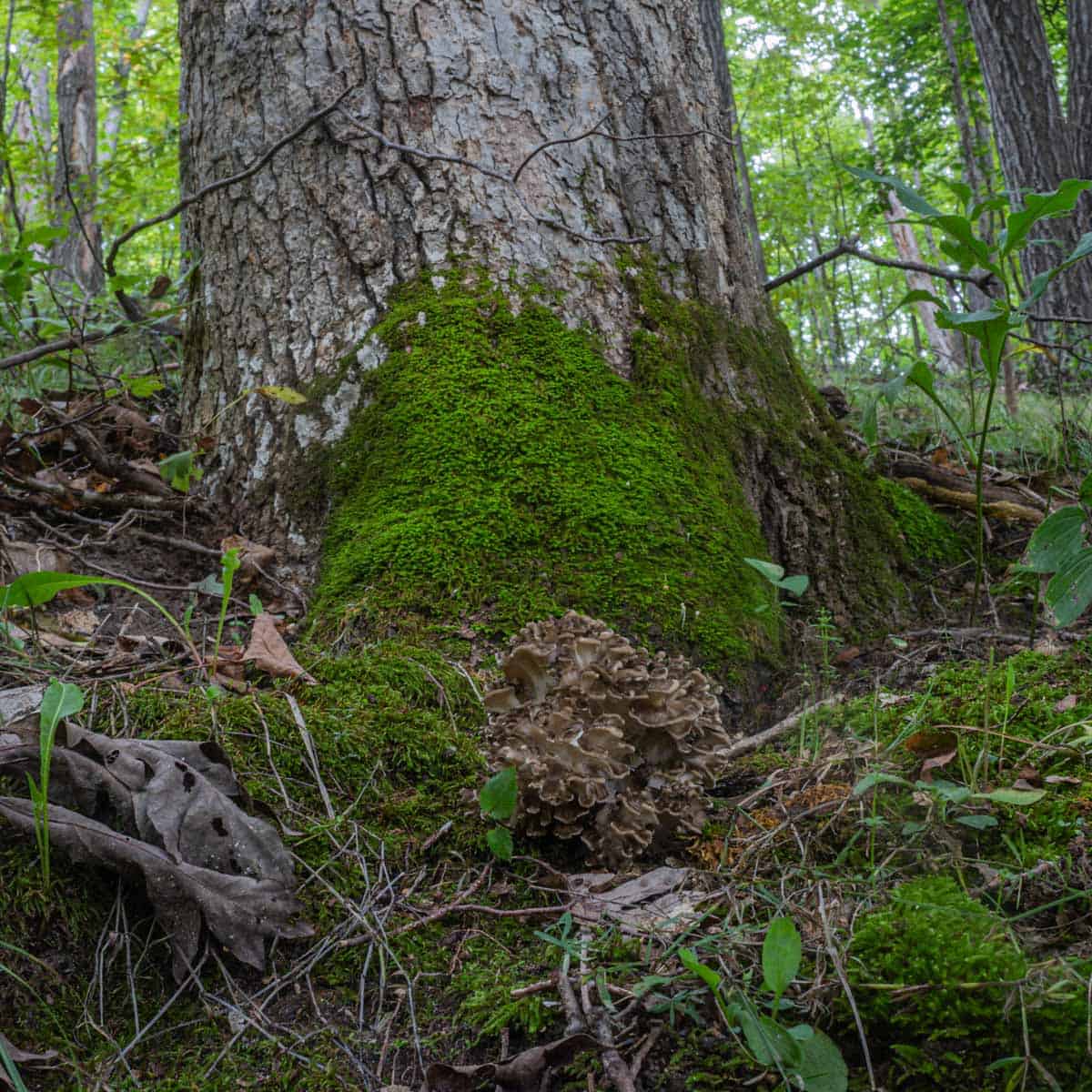
The mushrooms will come back year after year in the same location. When you find an infected grove, go there regularly once the mushrooms start to fruit. Different trees will give hens at different times throughout the season.
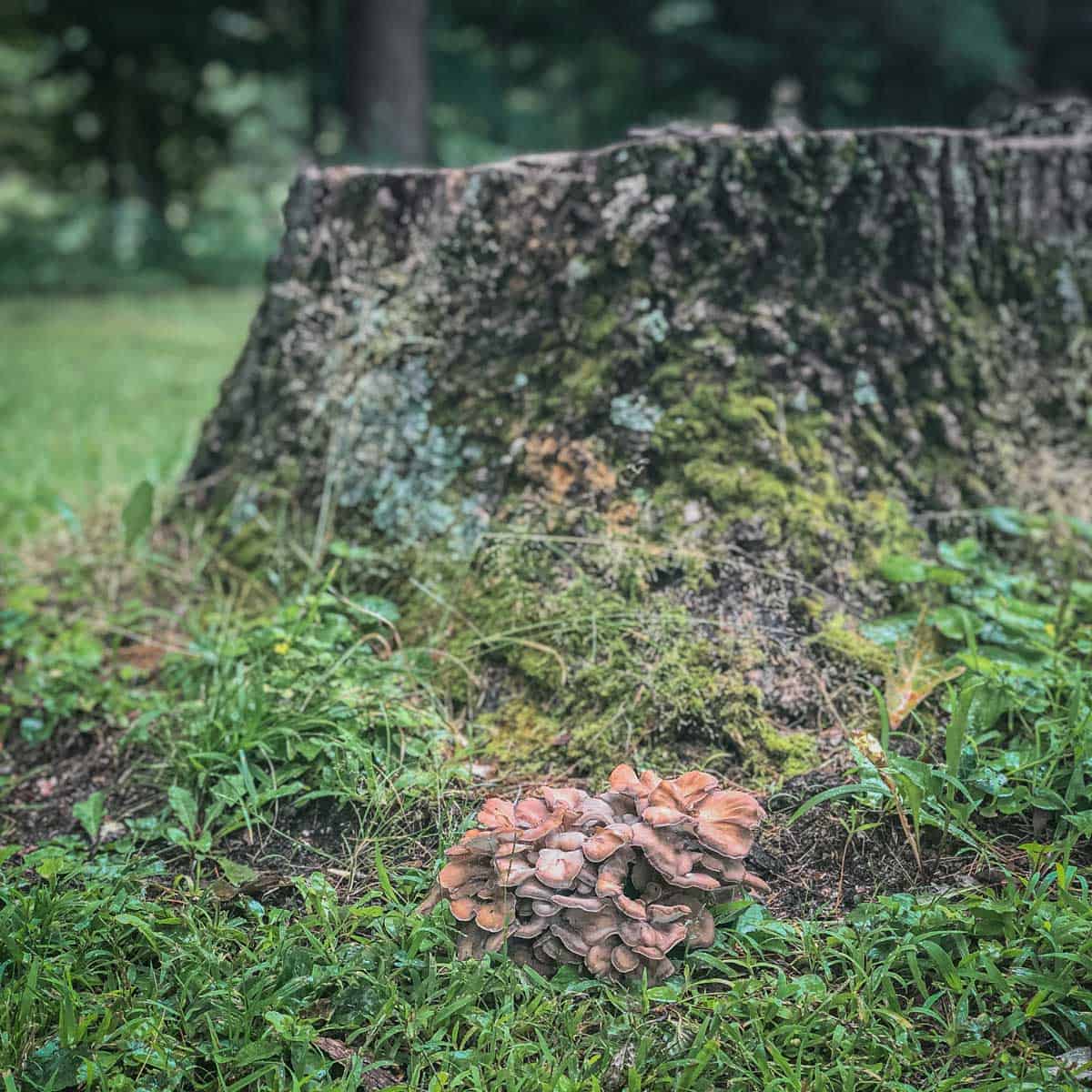
Hen of the Woods Look Alikes
There's a few mushrooms that look like hen of the woods, or could be confused with them, but here are no poisonous look alikes. Here's the top five you should know.
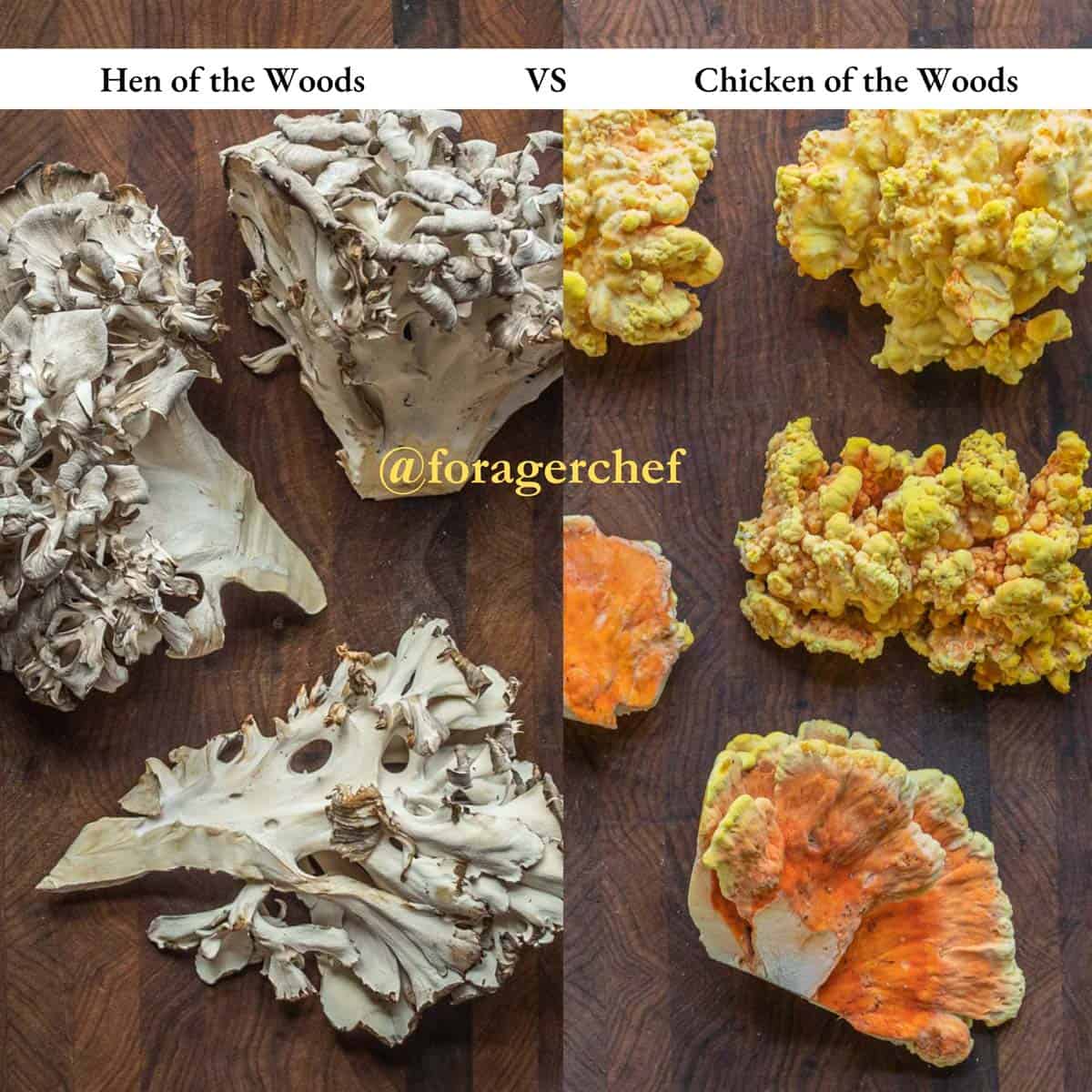
Umbrella Polypore / Polyporus umbellatus
The umbrella polypore (Polyporus umbellatus, formerly Grifola umbellata) is very good, but rare. It grows in the summer at the same time as hen of the woods, and can also be found on oak trees. It's easy to tell the difference from a true maitake as the caps of P. umbellatus have a funnel shape.
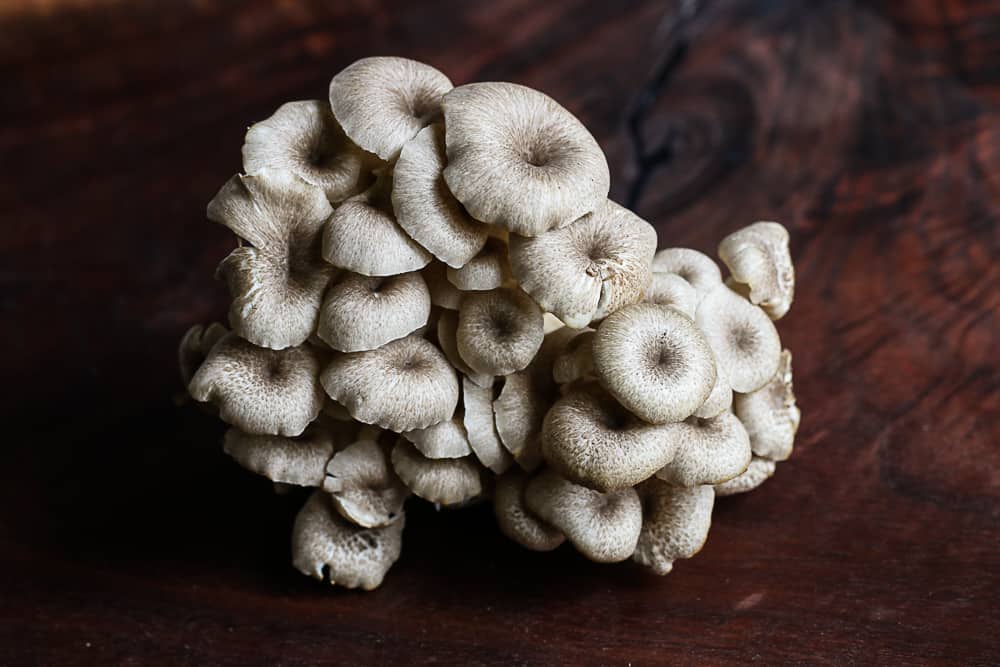
Black Staining Polypore (Meripilus sumstinei)
Also easily confused with hens, the black staining polypore also grows at the base of infected oak trees, but is easily identified from its black staining when bruised or handled. It's delicious, tasting like a hen crossed with black trumpet mushrooms.
It's tougher than hens, and need special treatment like drying and powdering. Cut the tender ½ inch margin into duxelles, or make them into stock and broth.
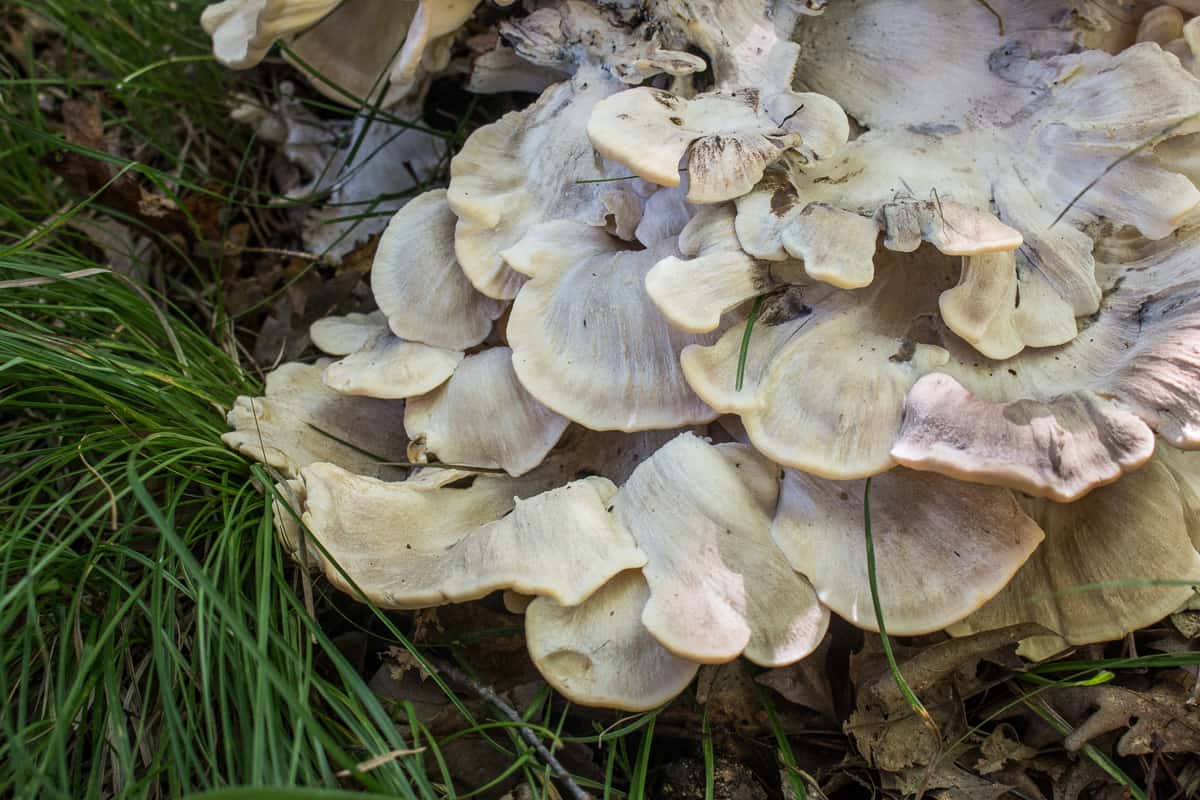
Berkley's Polypore (Meripilus giganteus)
A large cousin of the BSP, Berkley's polypore infects beech, pine, spruce and firs as well as oaks. Like other meripilus, it's very tough when mature, and only the tender outer edge should be used. I think they're best used to make duxelles or mushroom stock.
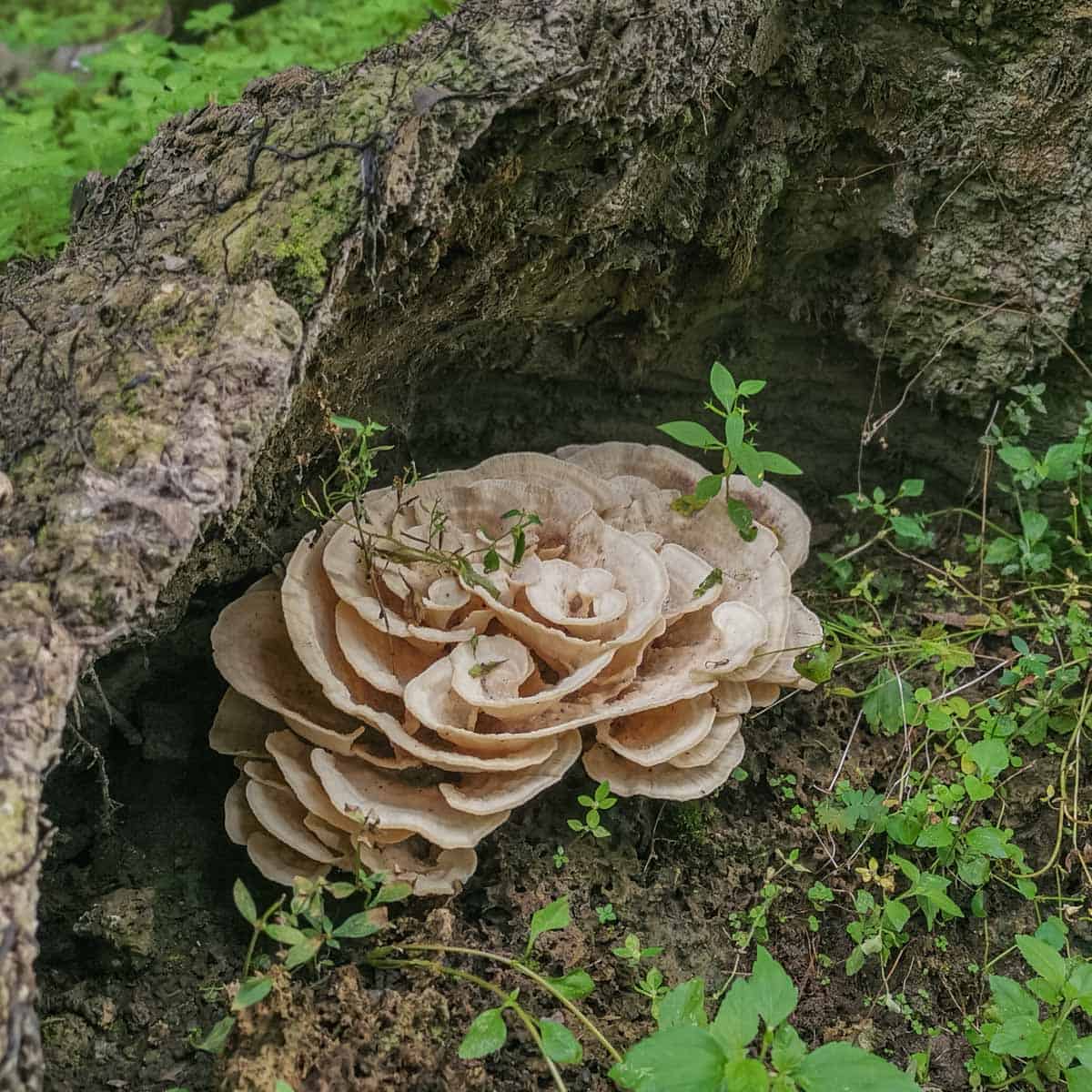
Bonderzewia
Another parasitic fungus that grows at the base of oak trees. These are a rare find for me but are definitely a mushroom that looks like hen of the woods. They seem far too tough to be useful, but many people still say that about black staining polypores. They're not harmful to my knowledge, but they would be very hard to chew.
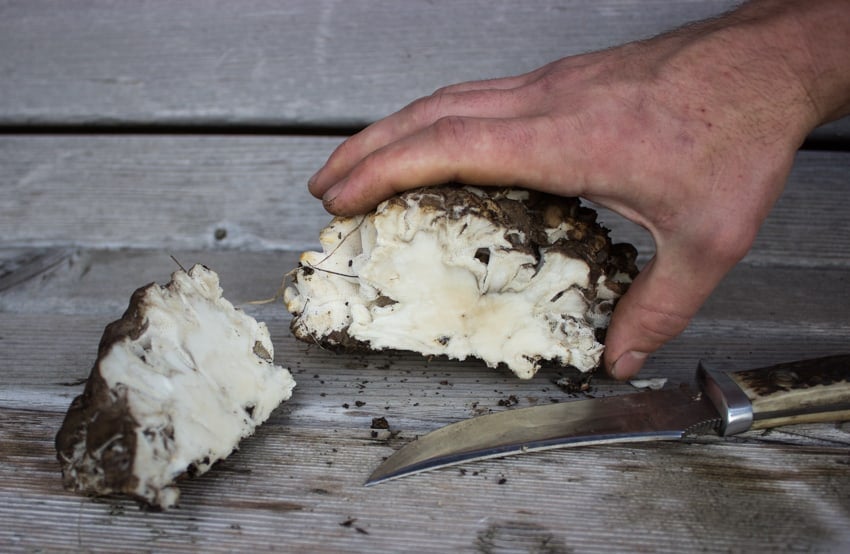
How to Harvest Hen of the Woods
The first thing to do is inspect the mushroom. If you can see white spores on the ground it's past-prime, but could still be ok to eat. Older mushrooms will be tougher, younger ones are more tender. Grasp the base of the mushroom and pull it up, then carefully trim any dirt from the stem.
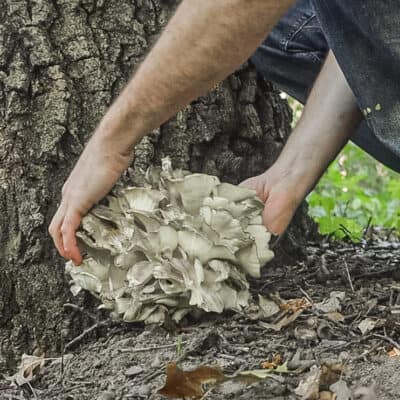
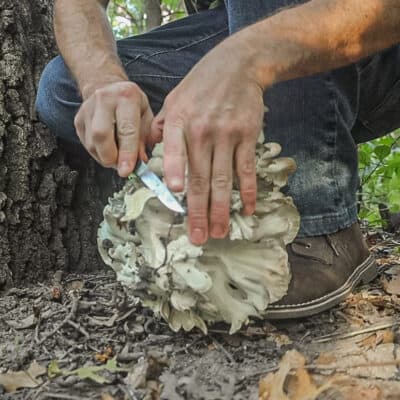
Inspect the mushroom closely for dirt, leaves and debris. If it rained recently you may want to pass. The best mushrooms should feel tender, and look very clean without grit stuck in or on the fronds.
Knowing when to harvest hen of the woods is important. Bigger is not necessarily better and waiting to see how long it takes a hen of the woods to grow can ruin your mushroom. Most of the time when I find a hen I take it unless it's just starting.
Older mushrooms that can be tough and buggy will usually have visible white spores around them-a sign you might want to keep looking for a better mushrooms. Hen of the woods grow moderately fast, so go back in 3-4 days if they're too small to harvest.
Below, left to right: older mushrooms will be tough, younger mushrooms are very tender, and perfect mushrooms are in the middle.
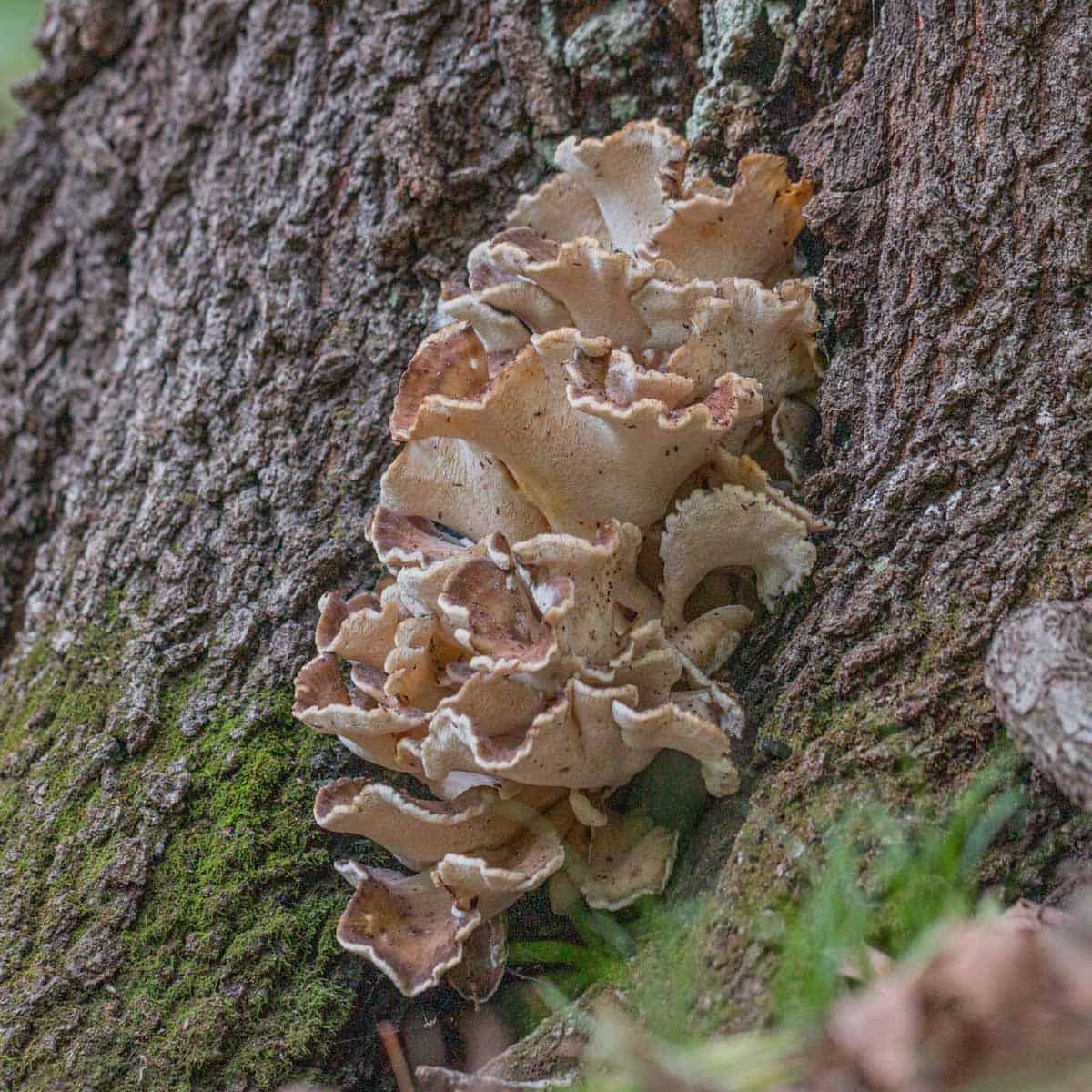
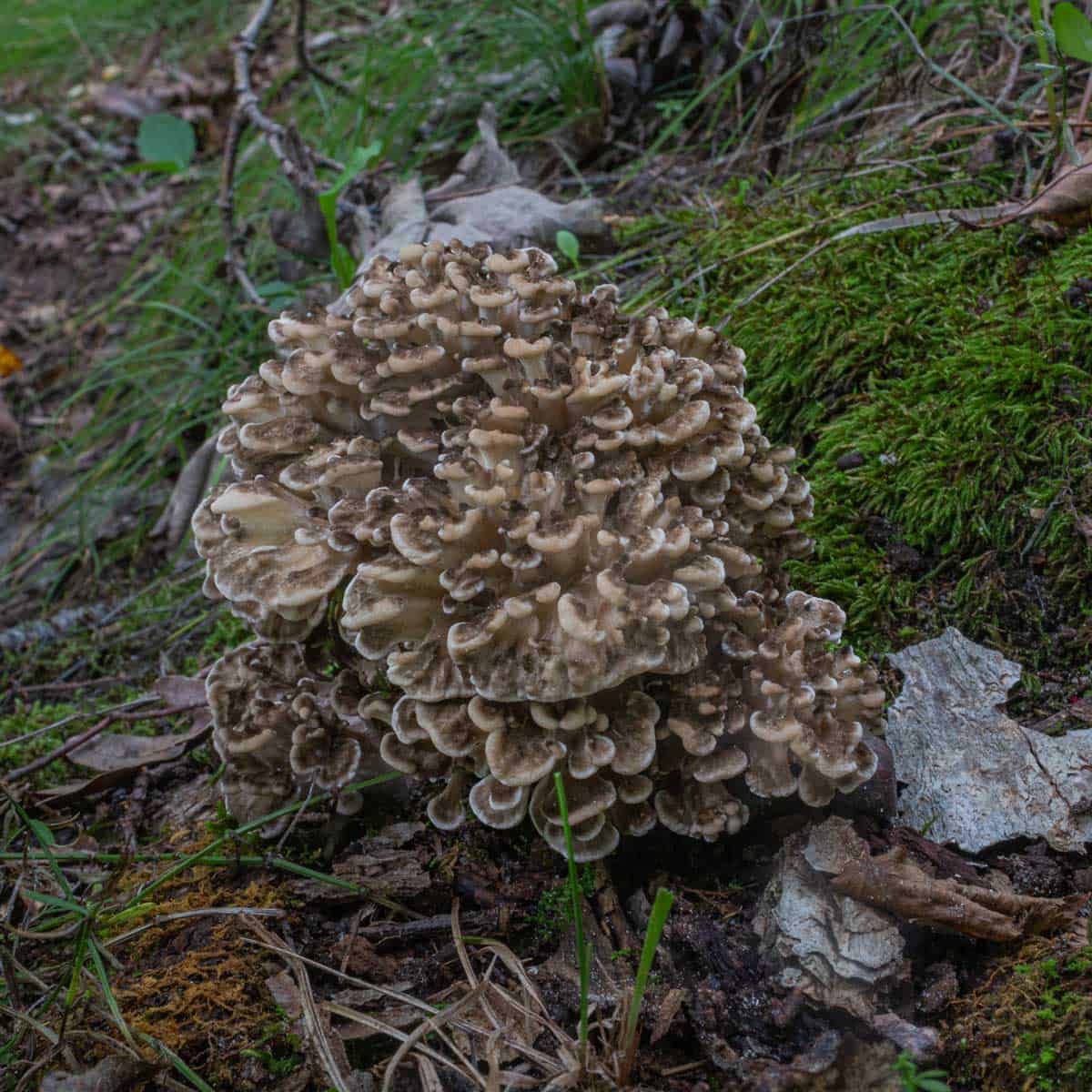
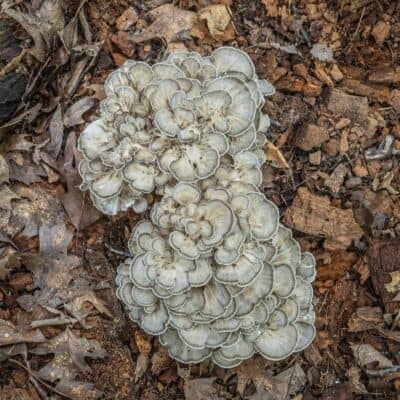
Hens are tricky enough to clean as it is, but if it rains, dirt will splash on the mushroom and dry, and the mushroom will physically absorb the dirt into its flesh as it grows.
How to Clean Hen of the Wood
These can be easy to clean, or very difficult depending on the growing conditions. First, you separate the mushroom into large leaves or clusters and inspect for twigs and debris. The flesh should be pure white-cut away dirty or discolored portions.
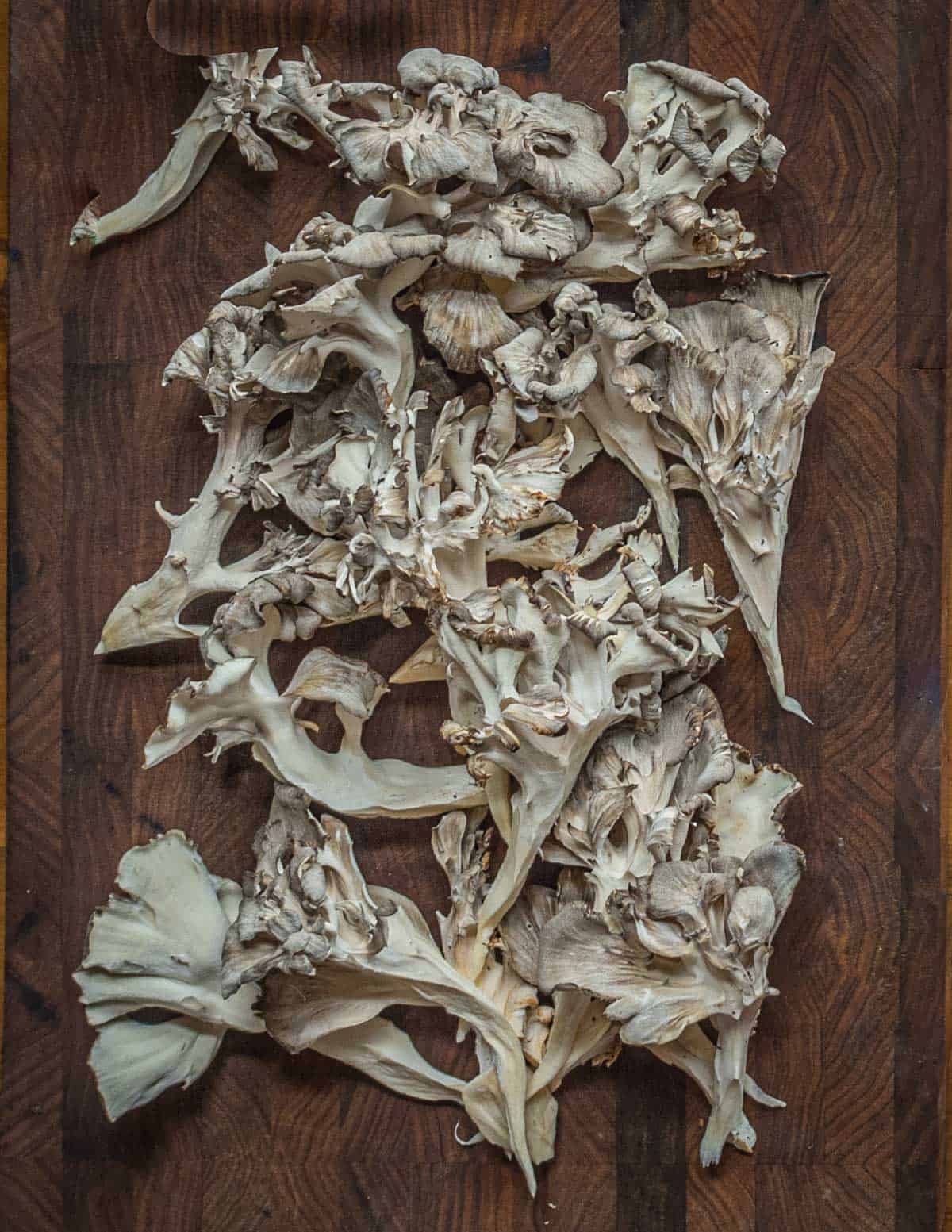
As the mushrooms age they turn a shade of dingy yellow-beige. Very clean mushrooms can be cut in thick slices, but finding them in a perfect stage can be tricky. Sometimes, especially after rain, the mushrooms can absorb dirt into their flesh making them impossible to clean. Larger, older mushrooms are usually more difficult to clean than young ones.
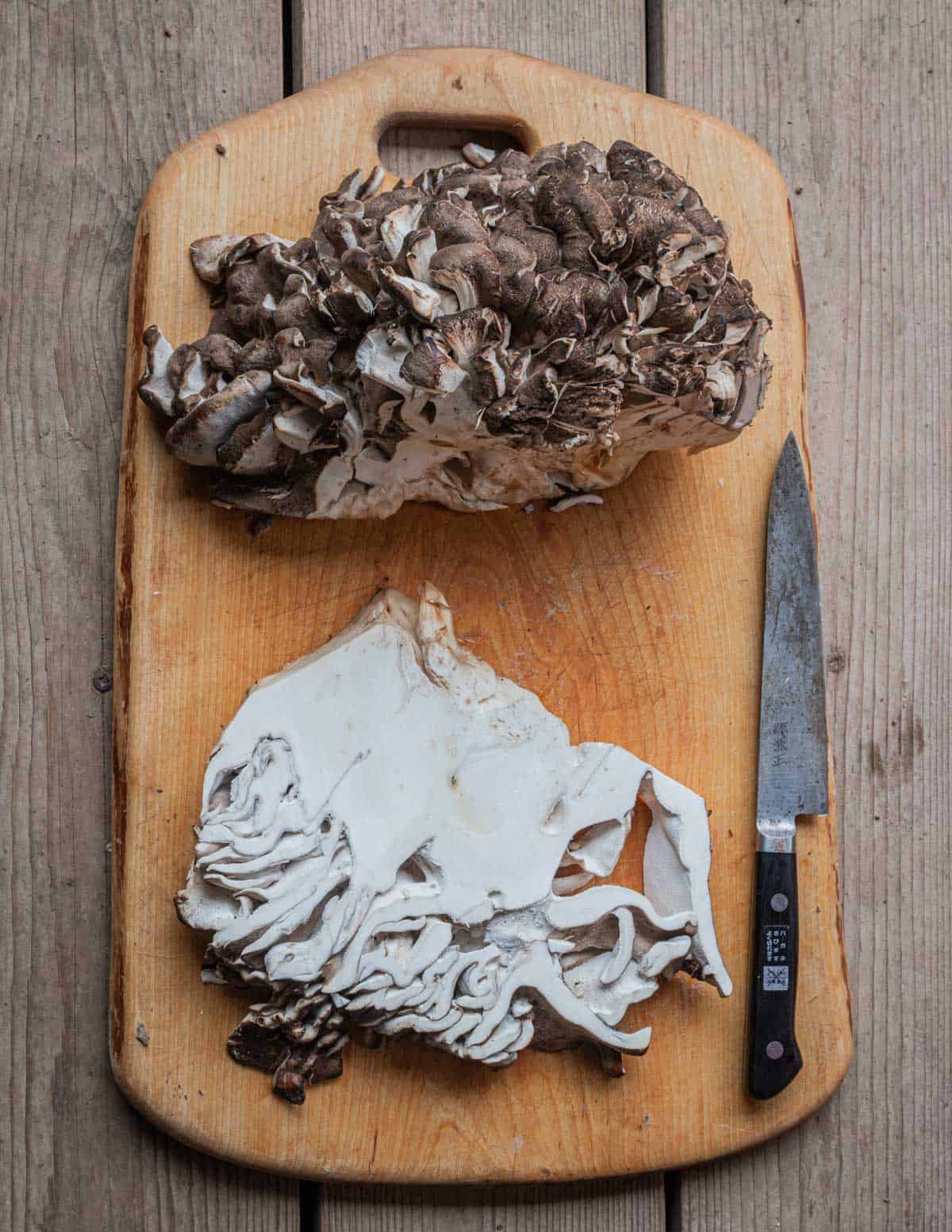
This might only be an acorn or a twig to remove, but debris is often lodged inside the mushroom flesh itself, as the mushrooms will absorb dirt that falls on them as they grow. One time a diner at a restaurant broke his tooth on a pebble in the mushroom itself.
The mushrooms are usually free of larvae but are often home to insects like pill bugs, centipedes, ants and spiders. I once found one with a baby snake inside. It's all part of Nature's design as the mushrooms function as shelter for small creatures. They're literally a bug hotel.
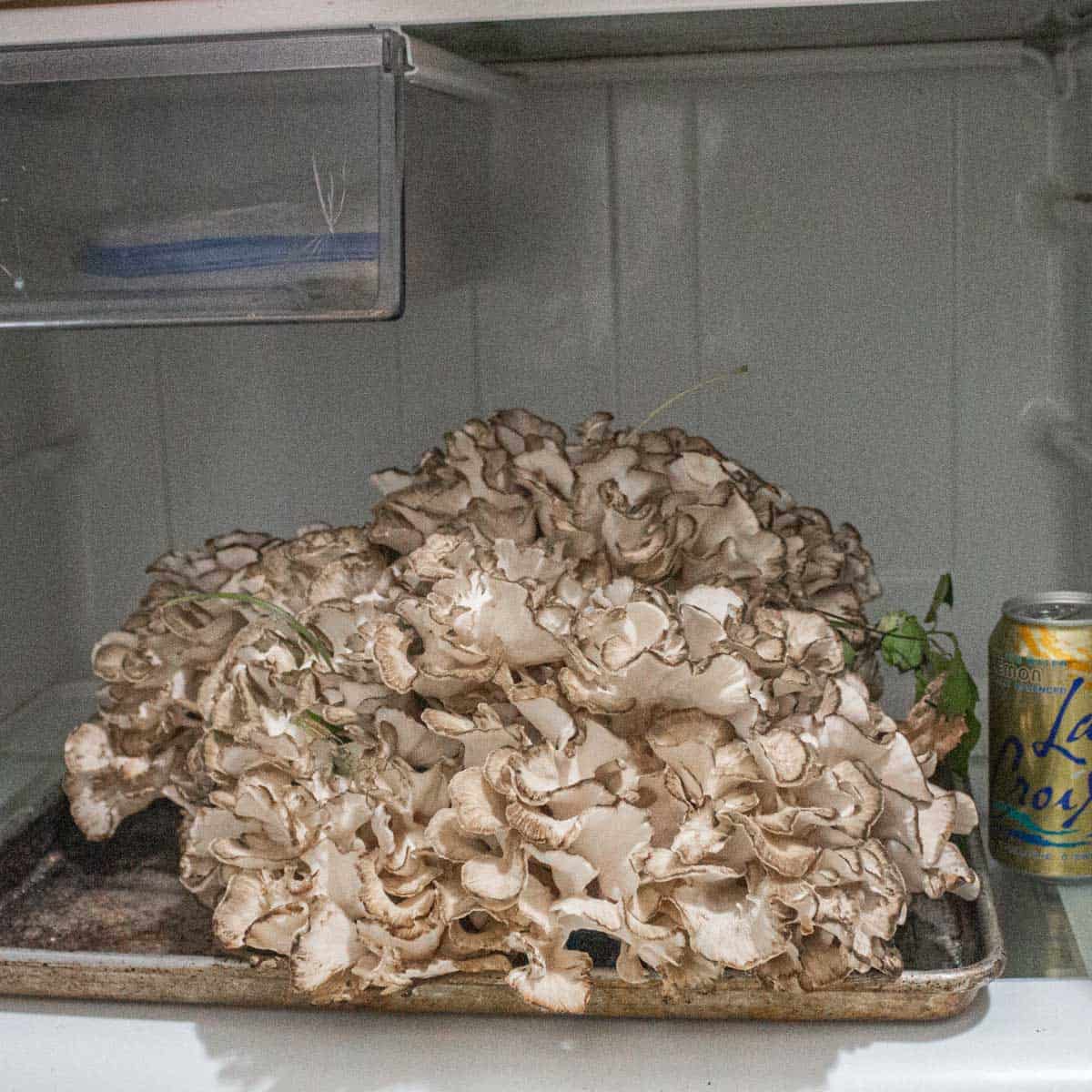
Once the mushrooms are cut, you can swish them in a sink of cold water, dry them on paper towels, and store the hen of the woods in a Zip Loc bag with a dry paper towel in the fridge. If you don't have time to clean them, store them whole in the fridge and clean them as soon as possible. Properly stored, the mushrooms will last for at least a week or more.
How to Cook Hen of The Woods
Hen of the woods taste meaty and delicious with a mild mushroom flavor. You can substitute them in just about any mushroom recipe, but keep in mind cultivated mushrooms grown on a substrate don't taste as good as wild ones. To cook, Just separate the mushrooms into bite size clusters and fry, sauté, stew, braise or roast them.
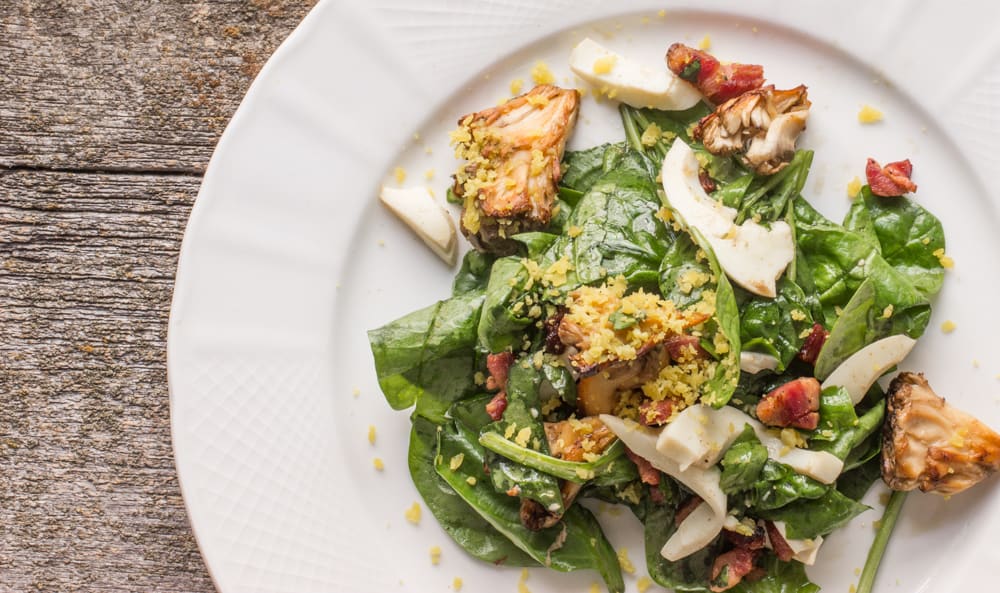
Their size also makes them a great mushroom meat substitute for vegan and vegetarian mushroom recipes like my Wild Mushroom Taco Meat.
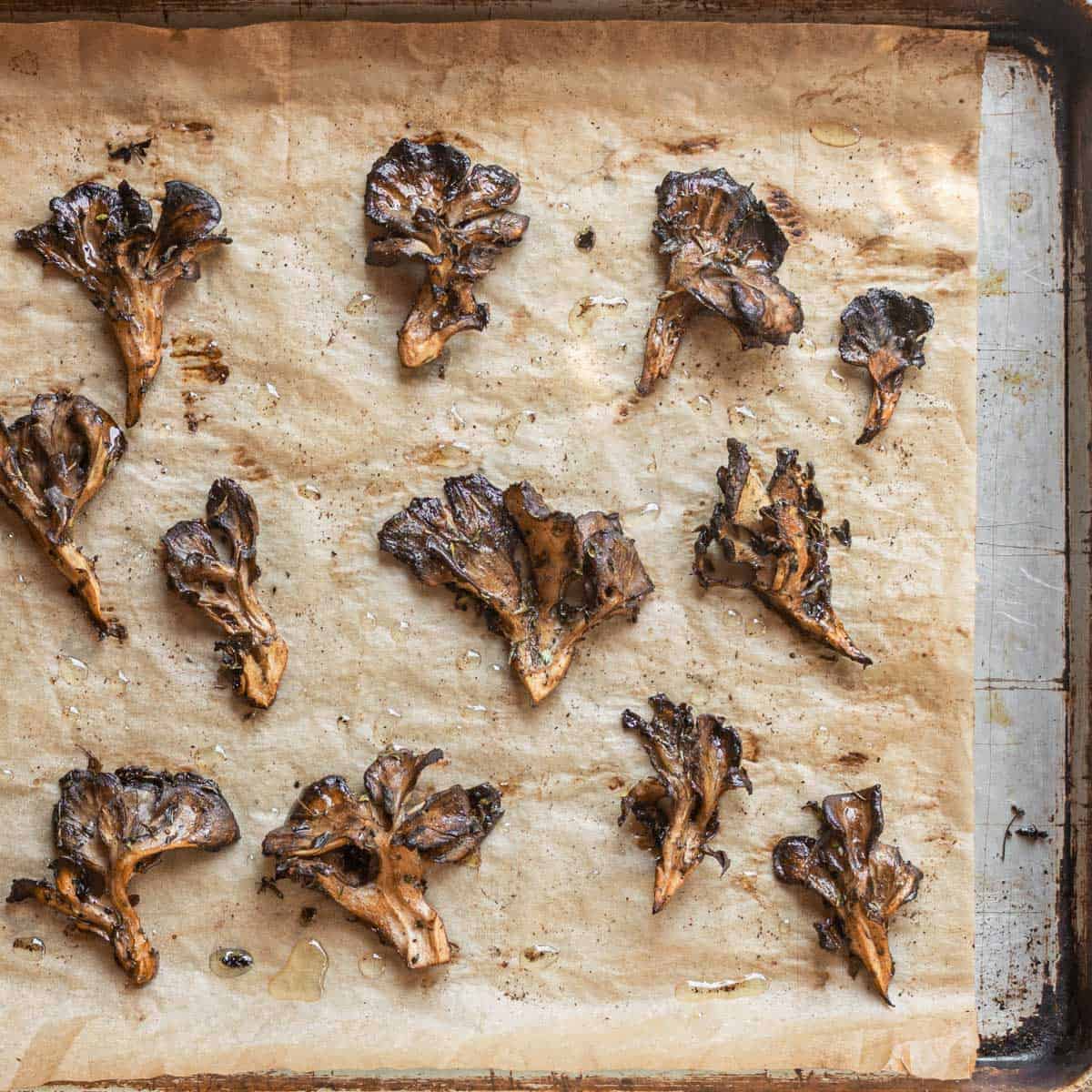
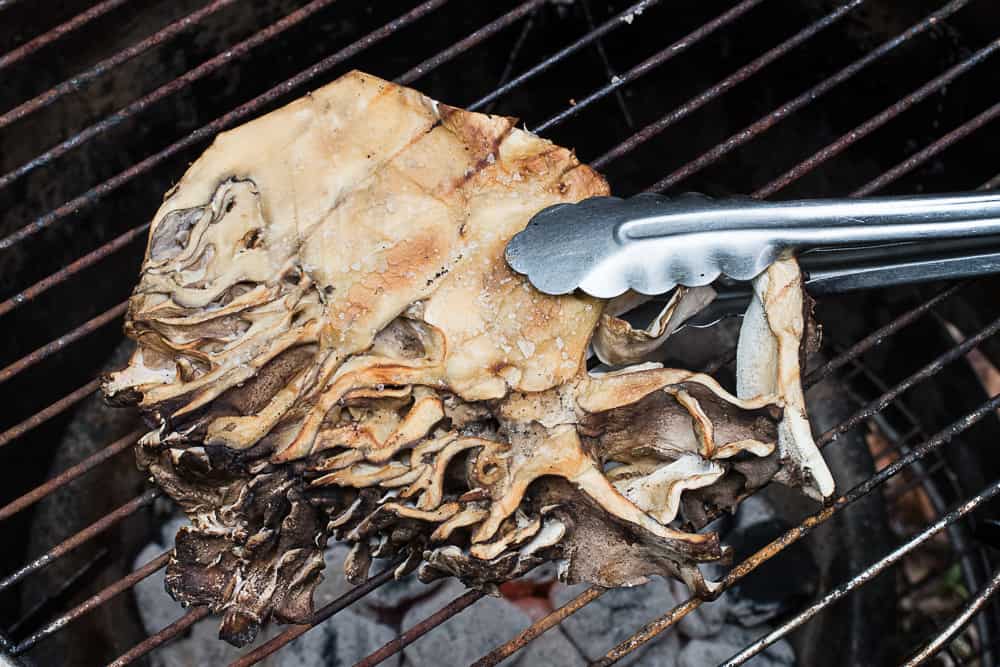
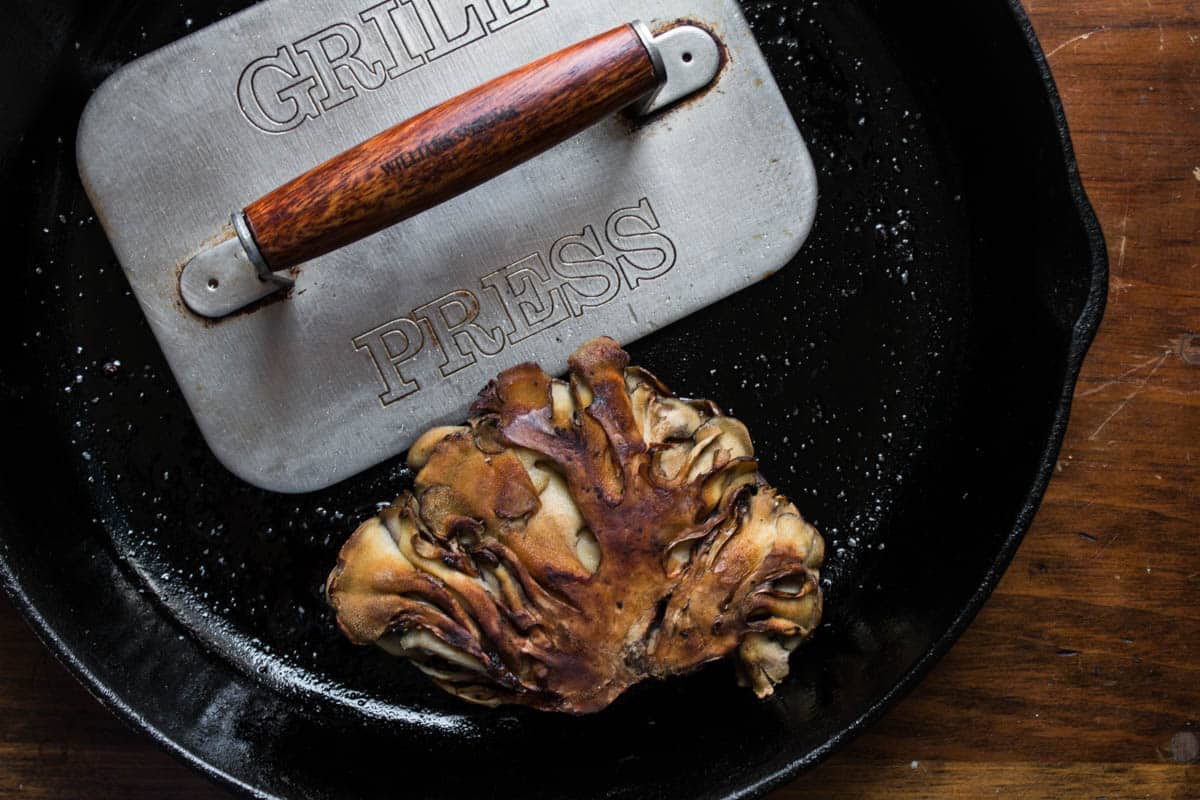
If you find a perfectly clean mushroom, a favorite hen of the woods recipe is roasted whole or cut into thick slices and grilled as hen of the woods steaks. You'll need young, very clean mushrooms to make steaks but when you find a good one, it can be an easy way to make a great meal.
To preserve them, the mushrooms can be, pickled, frozen, dried and/or powdered to use in seasoning blends for soups and sauces. Freeze drying works well too. Hen of the woods mushroom jerky is a crowd favorite too. Dried mushrooms become very tough, and are best used for stock where the mushrooms are discarded afterward.


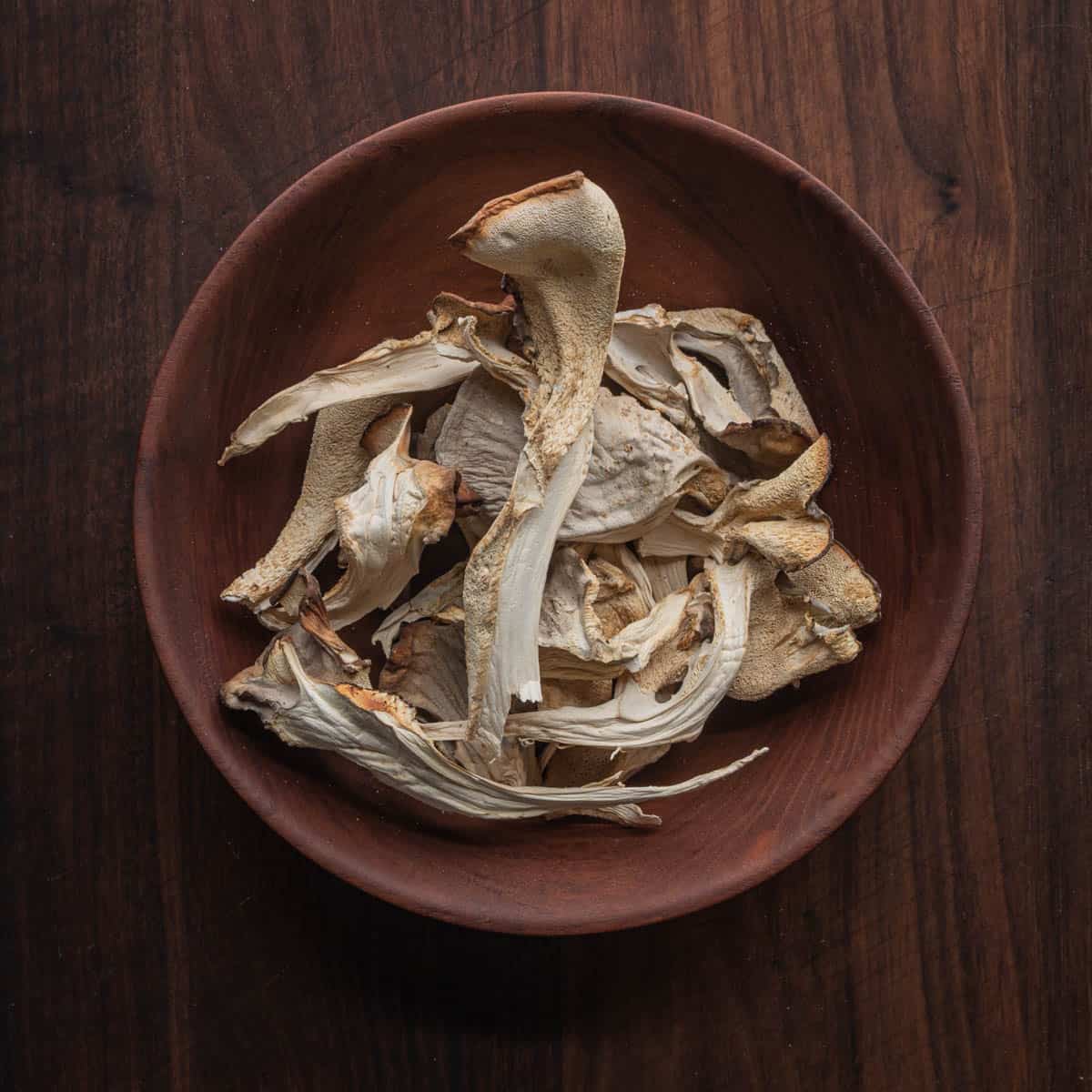
Freezing is a one of the best options to preserve these mushrooms and, unlike others, hen of the woods can be frozen raw or cooked. I usually cook my mushrooms before I freeze them. I make wild mushroom duxelles to use in stuffings, or cook and vacuum seal them as in my post on freezing wild mushrooms.
The IQF (individually quick-frozen) technique works well for freezing. To do it, take or a whole chunk or pieces of clean mushroom and put them on a cookie sheet lined with parchment. Freeze the hen mushrooms, place in a bag and vacuum seal. Cook the mushrooms straight from frozen.
Hen of the Woods Recipes
Recipes I've made specifically for maitake or where they would be good substitutes.
- Brown Butter-Sage Hen of the Woods
- Simple Roasted Hen of the Woods
- Pickled Hen of The Woods
- Mushroom Conserve
- Roasted Maitake Mushrooms with Anchovy Sauce
More Hen of the Woods Mushroom Recipes
FAQ
Put the cleaned mushrooms into a Zip Loc Bag with a paper towel. Open the bag occasionally to let them breathe. Cultivated mushrooms will last 3-4 days. Wild mushrooms will last a week or even longer.
Asian grocers usually carry the Hotko Brand maitake, a 3.5 oz package costs around 3.99. Wild maitake can be bought at farmers markets during the season for $10-25 / lb.
Yes, but they're slightly bitter. The fact that they taste so good cooked makes eating them raw unnecessary.
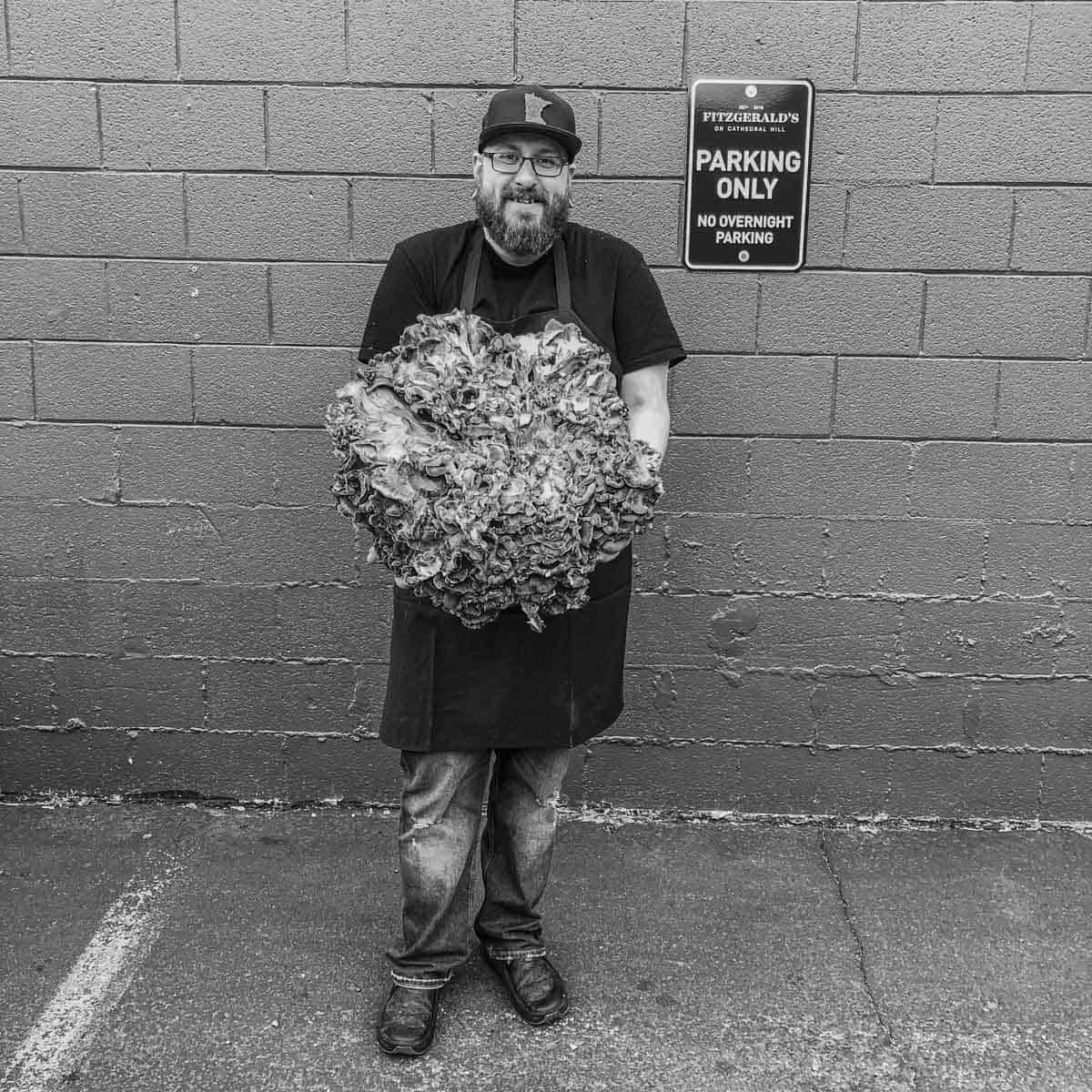

Adrien
Hi,
I foraged a maitake and it didn’t stain black during handling and was tender so I know for sure it wasn’t a black staining polyphore, however I tried to simmer it fresh and for some reason the pores are turning black. The pan was fairly crowded, but I am worried that this is some sort of unseen bacterial infection. The mushroom smelled very fresh when picked, is this just a result of pan overcrowding to liquid ratio? I’ve never had this happen before and I’m nervous.
Alan Bergo
Hmm. I haven't heard of this before. The mushrooms will darken when cooked or steamed a little, but they shouldn't turn jet black.
Sandy Lincoln
Yesterday I found what I thought was a Hen of the Woods under an oak on my property. I’ve found them before and thanks to Alan’s website, I learned how to clean, prepare and store them. This particular Hen didn’t look exactly like others I’ve found, so I sent a picture to Alan and he responded almost immediately to verify that it was a young Hen. It weighed almost 5 lbs.! I’m busy cleaning, slicing, bagging and freezing the slices for late fall and winter eating. Thanks Alan!
Alan Bergo
Happy to help!
Russ Sears
Great article.
I often find Hen of the Woods when it is a bit gone by. The signs I see are browning and larvae. I am curious how to know when some larvae is too many? or can they be removed with water rinsing or some other method?
Often I cant see them until I get the mushroom home and put it on the counter top and see the little (very tiny) larvae that fall off on the counter top and start moving around. This puts a lot of beginners of immediately.
Thanks for any advice
R Sears, Hull MA
Alan Bergo
Hi Russ. Great question. I rarely see the small white fungal gnat larvae in my hens so I feel for you there. To be clear, bugs are not dangerous, and as the mushrooms will be exposed to high heat before eating you can rest easy knowing there's a "kill step" as we say in the kitchen. Just how many bugs are acceptable in a mushroom is a matter of taste. I have a friend who will eat soggy morels and tell me they're great, and another friend who inspects the stem of every single chanterelle to make sure there isn't a single bug hole. My general rule is if the structural integrity and shelf life of the mushroom hasn't been compromised and it's still firm and fresh, it's probably fine. As hen of the woods are so large and function as a literal bug hotel it's a little more complicated with them. If you're picking hens and they have larvae, my best advice is to first trim the stem and try to not let the enthusiasm of finding the mushroom cloud your judgement. If you see white spores around the mushroom or small flies buzzing around it, it's probably too old. It can be easy to find them, but getting them at the perfect stage (and clean) is part skill, part luck and timing. The younger the hen, the better they'll be, and the easier they'll be to clean. Any discoloration is also a red flag that they're probably buggy. The next time you bring a hen home and see it's a little buggy it's fine to soak the mushrooms in cold water-make sure to pull them apart and begin the cleaning process too. The agitation will make them evacuate. Another good tip is to clean your wild food outside or in the garage first to hide the nasty bits from squeamish people.
Alana of the woods
I found a 13 lb hen yesterday and have little room in fridge or freezer to store it. Would you consider canning them with some salt as a shelf stable option? One day i will splurge on a freeze dryer! But til then, i am Hoping to preserve as much texture, flavor and nutrition as possible. Excellent article, by the way. Thank you for always providing such in depth info and recipes!
Alan Bergo
Hi Alana. If you can them like that without any acid they would need to be pressure canned. I typically cook and freeze mine.
Kevin
When you say, "cultivated mushrooms grown on a substrate don't taste as good as wild ones," is that a caution about the taste of commercially available hen-of-the-woods?
Alan Bergo
Hey Kevin, not necessarily. There's some important tradeoffs here. Most cultivated hens taste very mild compared to their wild cousins, but they're also perfectly clean. When I served them in restaurants the cultivated ones allowed me to serve them year round as a fun mushroom side dish. A perfectly clean, tender wild hen is very special though.
Kip
Do you have to harvest the whole hen at once or can you go back for more?
Alan Bergo
Hello. So, this year I actually found a hen that had regrown multiple pounds after it had been cut. But, generally speaking you will harvest the whole thing. If you don’t they will typically go bad.
John
There is always an ecosystem in the hens that I find. There are spiders, generally, and usually several different kinds, several different kinds of worms, and often bugs of different types, which, naturally explains the spiders. It's rare that a hen doesn't provide at least a dozen or so creatures when cleaning. Oh, yeah, and of course slugs which are probably the most prolific of all the mushroom eating creatures out there. The one thing they don't usually have, probably due to the cool weather they like, is the kind of bug worms that so often ruin the edible bolete type mushrooms that come in the summer.
Alan Bergo
It's so true. You should have seen me jump when a baby snake popped out of a big one. I kind of like the fact that they function as shelter for little critters. I definitely appreciate the lack of gnat larvae too, unlike chickens.
Fiona
Thanks for taking the time to write this article. Is it worth drying the stipe part of then mushroom to make into a powder for stock? I don't like to waste if I can use it.
Many thanks
Alan Bergo
Hi Fiona. Sure you can do that.
Donna
I am a novice, wild mushroom gatherer. You have explained the Hen of the woods, so well, I am going to give it a try to collect and cook when the next one shows up at my friends Oak Grove. He has several different varieties and I do remember the Hen I saw last Fall when helping to clean up the leaves.
Alan Bergo
Thanks Donna. Have fun they're a great mushroom.
Deb C.
I got one hen the past two years growing on the grass under my peach tree. This year I got two beautiful hens growing on the grass under the peach tree.
Alan Bergo
That's interesting. Never heard of peach trees before.
J Olsen
Great article. Now I feel like I actually know how to clean one.
Trevor Driscoll
That Spinach salad looks great! Is that recipe posted anywhere? I’ve never used hen in a salad before but I love the concept!!
Alan Bergo
Hey Trevor. Yes it's here. Hen of the Woods Salad.
Mary Howard
My red oak failed to produce last year (had previously been repetitive). Looks like nothing again this year??? Has mycelium died, or could it repeat next year?
Now a second tree (that has historically produced 3 hens) has none. This location is 30 miles away from our location. Is it likely to produce next year?
We have found 2 trees that produced (all different locations), but the hens were small.
It has been rather dry and hot here. Now cooling, reaching apx 55/45, no frost yet. SW Pa.
Alan Bergo
Keep going back. Sometimes they can skip a year or start to Peter out a bit as the consume the tree, from my experience. Rain is also important. My spots have been really empty this year too.
PJ
Somebody beat you to it?? My Dad kept his spots secret....but can't dig too deep either I recall
Jason Claeys
Keep looking they can grow in cold weather. My trees didn’t produce when they usually do it was too dry. Now I’m finding them in October after some decent rain
Alan Bergo
Thanks Jason.